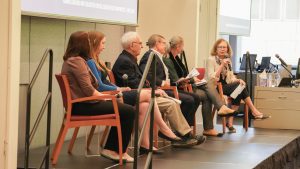Early childhood education enjoys bipartisan public support, and for good reason. Children who attend high-quality preschool are better prepared for kindergarten than children who do not. And while all children benefit from preschool, low-income children and children designated as dual language learners experience greater preschool learning gains than their more economically advantaged and English-proficient peers. In other words, high-quality preschool education is a critical lever for reducing early opportunity gaps.
Yet we also know that if we want the effects of quality preschool to persist, we need to look at what comes after. We cannot expect preschool gains to last unless followed by high-quality instruction in elementary school.
PreK to Third Grade Alignment
In addition to consistent high-quality instruction, policy makers, educators, and researchers are paying increasing attention to the need for alignment(also referred to as continuityor coherence) between preschool and elementary school education. Many districts across the country are implementing preK–3 initiatives designed to ensure high-quality AND coherent learning experiences for young children. This interest in alignment springs from concerns about the detrimental influence on student learning of disconnects between preschool and elementary curricula, assessments, instructional strategies, and teacher professional development. These misalignments, some educational experts argue, contribute to the fade out of preschool effects.
Increasing understanding of learning trajectories, or developmental progressions, in core subject areas including math, English language development, literacy, and science, also provides impetus to preK–3 alignment efforts. Armed with knowledge of how students acquire increasingly sophisticated levels of thinking to reach a learning goal, teachers can target instruction to promote children’s growth from one level to the next. [1] Sequencing curriculum and instruction to match typical learning trajectories helps children connect with and build upon what they learned previously, which we know from cognitive science facilitates further learning. [2]
DREME’s COHERE Research Project
While there are good reasons to anticipate that children would benefit from seamless educational experiences, systematic research on alignment is scarce and offers limited guidance as to what needs to be aligned, what are effective alignment strategies, and what are factors that facilitate or hinder alignment.
One of DREME’s projects, Preschool Through Elementary School Coherence (COHERE) is working to address that gap by studying the efforts of two urban California school districts, Almond Valley Unified and Cypress Unified, [3] to connect math educational experiences from preK through the early elementary grades. The study follows children over time and is ongoing, but we recently published a set of findings describing the districts’ approaches to fostering preK to elementary math alignment based on data we collected during the 2016–17 school year. We found similarities and differences in the ways Almond Valley and Cypress Unified pursued the goal of alignment. For example,
- Both districts elevated their directors of early learning to high level positions in their organizational charts to raise the profile of early childhood education and signal commitment to support for early education.
- Almond Valley moved kindergarten from the K–12 curriculum and instruction department to the early learning department, with the goal of strengthening the connection between preschool and elementary.
- Both districts established single-site leadership at elementary schools that have preschool classrooms on site, making principals responsible for overseeing preK classrooms in addition to the elementary grades.
- Almond Valley pursued math teaching and learning alignment in the context of broader district-wide efforts to align instructional supports. The district’s approach emphasized professional learning for school leaders, including a class designed by the early learning department to help principals support teacher instruction in the early grades.
- Cypress Unified relied less than Almond Valley on district-wide structures to foster preK–3 math alignment, instead investing heavily on aligning mathematics teaching and learning across preK through 12thgrade. In particular, Cypress put considerable effort on aligning math curriculum, pedagogy, assessment, and teacher professional development.
- Almond Valley used three different commercially available math curricula, one each for preK, transitional kindergarten (TK), and elementary. The district tried to create continuity through pacing guides that tied the curriculum to the standards. Cypress Unified, on the other hand, developed its own math curriculum all the way from preK through high school. The mathematics department worked closely with the early learning department on the preK and TK curriculum units.
- The two districts used different approaches to link preK and elementary professional development (PD) in mathematics. In Almond Valley, the district used the same PD format in preK and elementary (district-wide cycles of training), but the PD in preK did not always focus on the same content and pedagogical approaches as those in elementary. Cypress Unified used different PD models for preK (one-on-one coaching and professional learning communities) and elementary (school-based PD), but PD was focused on the same small set of high-leverage pedagogical strategies (e.g., math talks) across both preK and elementary.
For a detailed account of preK–elementary alignment strategies at the two districts and implications of our findings for district leaders, state policy makers, and funders, please access our full report by following this link: Fostering Pre-K to Elementary Alignment and Continuity in Urban School Districts: Challenges and Possibilities.
COHERE research is ongoing, and ultimately our goal is to study the extent to which the districts’ alignment efforts are accompanied by changes in teacher instruction and student learning. Check back often for upcoming findings, or sign up to receive periodic updates on the research and resources of the DREME Network.
[1] Clements D. H., Sarama J. (2010). Learning trajectories in early mathematics – Sequences of acquisition and teaching. In R. E. Tremblay, M. Boivin, & R. D. Peters (Eds.), Encyclopedia on Early Childhood Development.http://www.child-encyclopedia.com/numeracy/according-experts/learning-trajectories-early-mathematics-sequences-acquisition-and
[2] Stipek, D., Clements, D., Coburn, C., Franke, M., & Farran, D. (2017). PK–3: What does it mean for instruction? Social Policy Report, 30(2). https://dreme.stanford.edu/publications/pk-3-what-does-it-mean-instruction
[3] District names are pseudonyms



